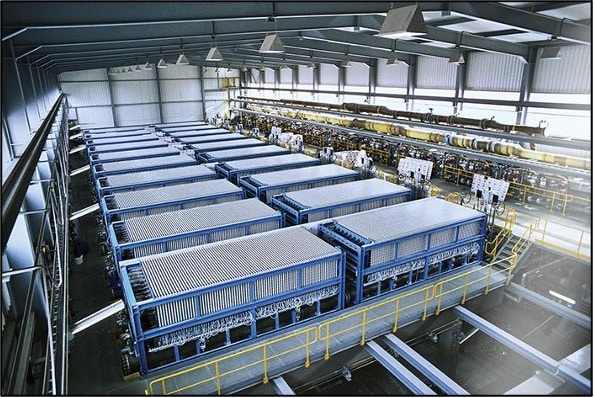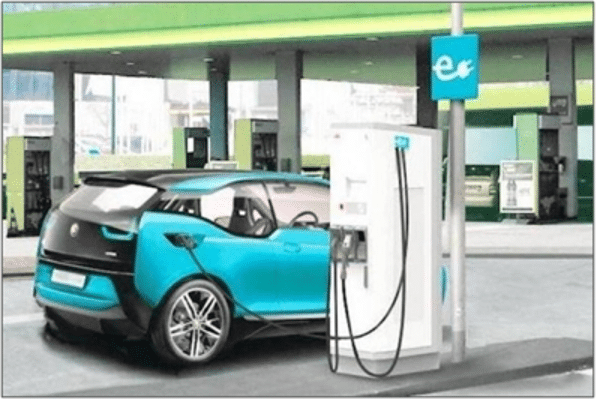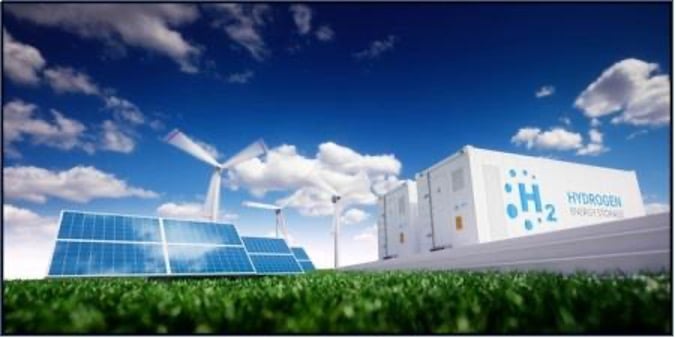India is the planet’s third-biggest emitter of greenhouse gases, after China and the US. In a bid to decarbonize India’s economy Government is giving top priority to renewable energy and also to a new fuel, termed ‘green hydrogen’. The potential of green hydrogen in the country was highlighted by last year’s report from The Energy and Resources Institute.
Globally, Hydrogen is the latest buzz for supplementing world’s energy needs. Being the cleanest form of energy, it can be produced from a variety of resources, such as natural gas, biomass, and renewable power like solar and wind. It can be used in cars, in houses, for portable power and in many more applications.
Green hydrogen is derived from water electrolysis using renewable energy such as solar or wind and can replace carbon-emitting fuels such as petrol and diesel, helping to meet United Nation’s Sustainable goals. Thrust is being provided by both private and public sector companies. For instance, National Thermal Power Corporation is working to set up India’s first green hydrogen fuelling station in Leh, Ladakh.
ONGOING Russia-Ukraine crisis added to uncertainty in the international energy markets. Given that India imports 85% of its oil and 55% of natural gas requirements, the energy security assumes paramount importance.
On the other hand, widespread use of fossil fuels is leading to environment degradation, playing havoc with our lives causing climate change including unprecedented rainfalls, hurricanes, landslides and melting of glaciers. In this disturbing scenario, alternatives in the form of renewable energy are actively sought for. Now a new candidate appears on the horizon.
Its name is Green hydrogen. Currently, all hydrogen consumed in India comes from fossil fuels. However, by 2050, three-fourths of all hydrogen is projected to be green, produced by renewable electricity and electrolysis.
Manufacturing process involves electrolysis to split water. It is different from ‘grey’ hydrogen, which is produced from methane and releases greenhouse gases into the atmosphere, and ‘blue’ hydrogen, which captures such emissions and stores them underground to prevent them causing climate change.
According to Goldman Sachs, Green hydrogen could supply up to 25% of the world’s energy needs by 2050 and become a $10 trillion addressable market by 2050. Scaling up green hydrogen will be essential to achieve net zero emissions by 2050 and limit global temperature rises to 1.5ᵒC.
Apart from the fact that green hydrogen is a sustainable and zero emission fuel, it is a better alternative to Electric Vehicles. Vehicles powered by green hydrogen fuel get charged faster as compared to EVs. Moreover, green hydrogen as auto fuel is also a cleaner alternative as its method of generation uses only renewable resources, whereas substantial fraction of electricity is still generated using fossil fuels.

Corporates Initiatives
India announced Green Hydrogen Mission on 15th August 2021. As a result of the propitious policy ecosystem, many companies announced their plans to enter the field.
Reliance, Adani Group, Indian Oil and National Thermal Power Corporation (NTPC) among others are leading India’s mission to adopt green hydrogen. Mukesh Ambani-led Reliance Industries recently announced its hydrogen plans to become a net carbon-zero firm by 2035. The company aims to replace transportation fuels with clean electricity and hydrogen. In March last year, the Adani Group announced a partnership with Maire Tecnimont to develop green hydrogen projects. Indian Oil Co has a wind power project in Rajasthan, from where, it intends to wheel power to Mathura refinery to produce green hydrogen through electrolysis.
NTPC announced its plans to set up India’s first green hydrogen fuelling station in Leh, Ladakh. It is looking to set up a pilot project for blending hydrogen with national gas for use in city gas distribution. Additionally, NTPC plans to produce green hydrogen from its upcoming 4,750 MW renewable energy park at the Rann of Kutch. Currently, it is running a pilot project in its Vindhyanchal unit, where the cost of hydrogen is estimated to be around $2.8-3/kg. It also plans to come up with a stand-alone green hydrogen manufacturing unit in Kochi that will draw energy from the solar power facility of the Kochi International Airport.
Oil India is setting up a plant to manufacture green hydrogen at its oilfield in Assam. The company has initiated action for setting up 100 kW green hydrogen plant at its pump station-3 in Jorhat. The pilot plant will generate green hydrogen using AEM technology. This is a first-of-its-kind project in the country. The hydrogen so generated will be blended with natural gas using the existing infrastructure.
GAIL (India) plans to build India’s largest green hydrogen plant for which it finalized 2-3 sites including one at Vijaipur in MP. It will take 12-14 months to set up the plant. The hydrogen so produced can be sold to fertiliser units which as per government mandate are required to use hydrogen as fuel.
Fusion Fuel Green — which has offices in Ireland and Portugal —signed an agreement with BGR Energy Systems, Chennai for development of green hydrogen projects in India. It will use proprietary technology from Fusion Fuel Green which produces hydrogen using solar energy. Green hydrogen will be used as a feedstock for other heavy industrial applications. Acme Solar Holdings Ltd also announced its green hydrogen plans.
Engineering major, L&T plans to set up a green hydrogen plants at Hazira complex and other manufacturing units. It will spend between Rs.10-50 bn on its green initiatives, spread over a number of years.
Background
Described by the International Energy Agency as a “versatile energy carrier,” hydrogen has a diverse range of applications and can be deployed in sectors such as industry and transport. Examples of its use in transport include cars, buses, trains, and airplanes.
Hydrogen can be produced in a number of ways. One method includes using electrolysis, with an electric current splitting water into oxygen and hydrogen. If the electricity used in the process comes from a renewable source such as wind or solar then it’s termed “green” hydrogen.
So-called “blue hydrogen” refers to hydrogen produced using fossil fuels — usually natural gas — with the associated emissions captured and stored. Green hydrogen — which is currently expensive to produce — accounted for just 0.1% of worldwide hydrogen production in 2020, according to Wood Mackenzie.

India’s aims: The potential of green hydrogen in India was highlighted by a recent report from The Energy and Resources Institute. It projects that by 2050, 80% of India’s hydrogen is projected to be ‘green’. In the mid-term, the cost of hydrogen from renewables would drop by over 50% by 2030, enabling it to start to compete with hydrogen produced from fossil fuels.
Government is targeting 450 GW of renewable capacity by 2030. The ambition to become a more sustainable country represents a significant challenge: India is the planet’s third biggest emitter of greenhouse gases, with only China and the US ahead of it.
A changing landscape: In February, India’s Ministry of Petroleum & Natural Gas said a statement of intent had been signed between Indian Oil and Greenstat Hydrogen India, a subsidiary of Norwegian energy company Greenstat, to establish a Center of Excellence on Hydrogen to promote R&D projects in Green and Blue Hydrogen between Norwegian and Indian R&D institutions/universities. Greenko Group and Belgium’s John Cockerill plan to set up a 2 GW electrolyzer factory in India, through their joint venture at an investment of $500 million. This facility has the potential to help replace around 8% of India’s annual liquified natural gas (LNG) imports.
According to IEA’s World Energy Outlook 2020, battery storage will gain huge ground as a source of power system flexibility, with global investment increasing six-fold to $25 billion by 2030.
Even as the country aims to reduce fossil fuel-based emissions by building renewable energy capacity and promoting the uptake of electric vehicles, the cost of such a transition remains unaffordable for many Indian consumers.

Industry’s Challenges
Industry has a number of challenges to overcome. First of all, Hydrogen research in the country is underfunded. In the 2020-21 budget, only Rs.250 m was allocated to the Ministry of New and Renewable Energy for hydrogen-related R&D. In comparison, Rs.61 bn was offered by the German government to firms working on green hydrogen alone.
Producing green hydrogen is an expensive undertaking with the biggest cost being the electrolyzer. The membrane-electrode unit accounts for 60% to 70% of its cost while precious metals account for the rest. Hydrogen is also an expensive fuel to move. The gas needs to be cooled to -252°C before transportation. While it can be stored as ammonia, a more stable form, reconversion is expensive.
Global Initiative
Over 8,000 hydrogen cars are on US roads. USA’s new initiative aims to cut the cost of production of green hydrogen to less than $2/kg, which would help to cut emissions from the world’s most carbon-intensive industries including steel-making, shipping, chemicals production and power generation. A number of countries have recently published national hydrogen strategies, including Australia, Chile, Germany, the EU, Japan, New Zealand, Portugal, Spain and South Korea.
The European Commission is working on a Clean Hydrogen Alliance while the German government is debating its national hydrogen strategy. Recently, Airbus, the world’s second largest aviation manufacturer, revealed prototypes for a hydrogen fuel passenger aircraft and a timeline for production to 2035, the International Renewable Energy Agency (IRENA) gathered global public and industry stakeholders to discuss how green hydrogen can advance towards cost competitiveness.
Of Germany’s EUR 9 billion investment earmarked for green hydrogen production, close to a quarter of it will support international cooperation, recognizing the potential need to import the fuel in large quantities as national policies stimulate demand. The cost reductions needed to make hydrogen competitive with fossil fuels remain contingent upon rapid and significant scale-up of its production. According to Michele Azalbert, representing the Hydrogen Council, by 2050, hydrogen could be a $2.5 trillion industry employing workforce of 30 million.
Author is with Department of Electronics Communication Engineering, Ajay Kumar Garg Engineering College, 27 Kmstone, NH-24, Adhyatmic Nagar, Ghaziabad 201009 UP India [email protected] 9868041558







Hydrogen is a very difficult product to store and by the time you generate it and use it in say a vehicle, the costs are much higher than a battery-driven vehicle.
It is absurd to use the electricity produced by wind, solar and waves to be used in any other form than directly delivering it to consumers for lighting, cooking and maybe heating.
I am interested for green hydrogen fuel in Ayodhya city